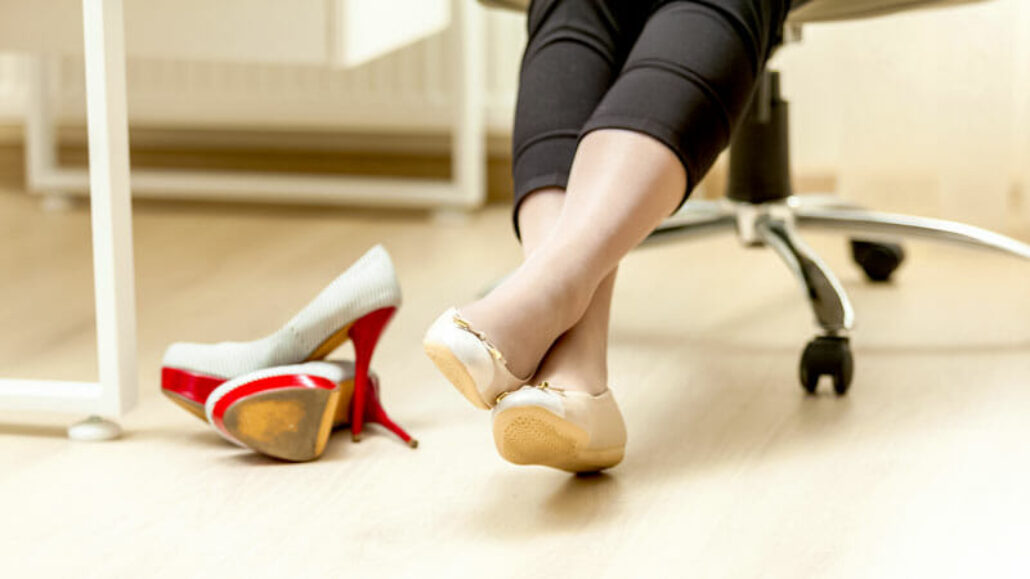Bunions are common foot deformities. We explain the causes of this sometimes painful condition, and discusses available treatments.
Our feet carry us through life’s journey, and we would all prefer walking through our days painlessly. If our stride incorporates a striking pair of shoes, even better! But when walking begins to cause us pain, we notice. A wide variety of conditions can cause foot pain, foot deformities among them. One of the most common foot deformities is a bunion.
How does a bunion form?
Bunions are bumps that form at the base of the big toe where the toe joint attaches to the foot. It is caused when shoes don’t fit well, and push the big toe toward the rest of the toes. When the big toe is squeezed toward the other toes, the base of the big toe pushes outward on the first metatarsal bone—the bone directly behind the big toe. Over time, continual pressure will reshape the metatarsal bone’s position in the joint, causing it to jut out as the hard knob we know as a bunion.
Do the shoes I wear matter?
Experts aren’t sure whether high heels and tight shoes with pointed toes actually cause bunions, or simply contribute to their development. Although an inherited foot shape or foot injury may contribute to the development of bunions, footwear is the focus for prevention of this foot deformity.
Shoe wear is the primary reason that we develop bunions. This doesn’t mean that women should never wear heels with a tight toe box, but problems develop when you make inappropriate shoe wear a day-to-day habit. Some patients want to know if they developed bunions because their mother had them. We explain that this issue is probably related to shoe wear, not genetics.
What can I do about it?
When bunion development is addressed early, treatment can be as simple as varying shoe selection. Try changing to more comfortable shoes that have a wider toe box and a flatter heel. You can wear still wear heels—just limit how often you wear them, particularly if you notice that you are getting a bunion that is symptomatic or painful.
For patients experiencing pain, toe spacers can help. This small silicon device looks like an I-beam, and you can buy it in the foot section of most pharmacy departments. You place the spacer between your big and second toe to help hold your big toe straight. This device won’t correct the problem; usually the big toe goes back into the deformed position as soon as you remove the spacer. But often, wearing a toe spacer with shoes will make bunion patients more comfortable.
Bunion treatments always begin with more conservative approaches like footwear and toe spacers. If these treatments don’t provide pain relief, then surgical options may be considered.
Summit Orthopedics offers personalized foot and ankle expertise
Our fellowship-trained foot and ankle physicians understand that your mobility depends on the health of your feet and ankles. If you have suffered an injury or are experiencing symptoms that make walking painful, our team of foot and ankle specialists can help with conservative treatment, seasoned surgical teams, and expert rehabilitation support. Summit Orthopedics specialists have the expertise to evaluate your discomfort and develop a plan to quickly and safely get you back on your feet and on your way.
Start your journey to optimal foot health. Find your foot and ankle expert, request an appointment online, or call us at (651) 968–5201 to schedule a consultation.
Summit has convenient locations across the Minneapolis-St. Paul metro area, serving Minnesota and western Wisconsin. We have state-of-the-art centers for comprehensive orthopedic care in Eagan, MN, Plymouth, MN, Vadnais Heights, MN, and Woodbury, MN, as well as additional community clinics throughout the metro and southern Minnesota.
More resources for you
- Watch the video: Does weight affect my feet and ankles?
- Are Flip Flops Dangerous For Your Feet?
- Ask Dr. Anderson: Can a Ganglion Cyst Be Dangerous?
